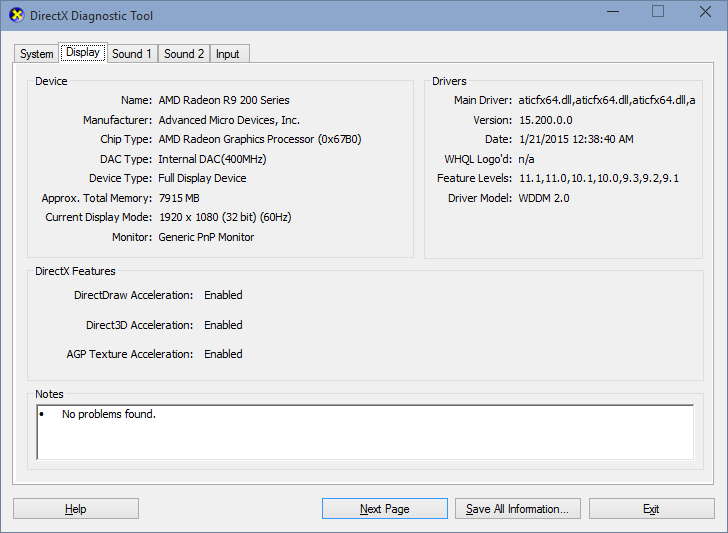Summary
4 ways to open DirectX Diagnostic Tool in Windows 10: Way 1: Open it through searching. Type dxdiag in the lower-left search box on desktop, and click dxdiag on the top of the list. Way 2: Turn it on in CMD. Step 1: Access Command Prompt. Step 2: Input dxdiag.exe, and press Enter on the keyboard. Way 3: Open it via Run.

- DxDiag ('DirectX Diagnostic Tool') is a diagnostics tool used to test DirectX functionality and troubleshoot video- or sound-related hardware problems. DirectX Diagnostic can save text files with the scan results.
- How To Check Computer Properties Using Directx Diagnostic Tool - Dxdiag - Windows 10Fore More Information Visit - https://mauricemutetingundi.blogspot.com/20.
This article describes how to determine the version of Microsoft DirectX that is installed on your computer by using the DirectX Diagnostic Tool.
More Information
To use the DirectX Diagnostic Tool to determine the version of DirectX that is installed on your computer, follow these steps:
Click Start, and then click Run.
Type dxdiag, and then click OK.
On the System tab, note the version of DirectX that is displayed on the DirectX Version line.
On the various tabs, check the version information for each DirectX file.
When you are finished checking file versions, click Exit.

If Windows cannot find the dxdiag program, DirectX version 5.0 or an earlier version of DirectX is installed on your computer. If this is the case, download and install the latest version of DirectX.
To download the latest version of DirectX, click the following article number to view the article in the Microsoft Knowledge Base:
179113 How to download and install DirectX

DxDiag from DirectX 12 (10.00.16299.0000) running on Windows 10 and DirectX 12 | |
| Developer(s) | Microsoft |
|---|---|
| Operating system | Microsoft Windows |
| Platform | 32-bit, 64-bit |
| Predecessor | DXInfo |
| License | |
DxDiag ('DirectX Diagnostic Tool') is a diagnostics tool used to test DirectX functionality and troubleshoot video- or sound-related hardware problems. DirectX Diagnostic can save text files with the scan results. These files are often posted in tech forums or attached to support emails in order to give support personnel a better idea of the PC the requester is using in case the error is due to a hardware failure or incompatibility.
DxDiag is located in %SystemRoot%System32.[1] Starting from Windows Vista, DxDiag only shows information; it is no longer possible to test the hardware and the various DirectX components.[2]
Functions[edit]
The System tab displays the current DirectX version, the computer's hostname, the operating system's version, information on the system BIOS, and other data. The DirectX Files tab displays information about the versions of specific DirectX system files, which are portable executables or dynamic-link libraries (DLLs).
DxDiag displays information about the current display settings and the video hardware on the Display tab. If the computer has more than one monitor, then DxDiag will display a separate tab for each monitor. This tab can disable DirectDraw, Direct3D, and/or AGP Texture Acceleration for troubleshooting purposes. If the installed display driver has passed Windows Hardware Quality Labs testing, DxDiag will display this result on the right side of the window.
The Music tab displays information about the computer's MIDI settings, and lists different music-related software and hardware on your computer. The Input tab, displays information about input devices installed in the computer such as keyboards and mice. It will also attempt to detect problems with these devices. DxDiag also displays information about the installed DirectPlay Service Provider.
It is possible to create chat rooms with DxDiag that can be accessed by other computers, as long as anyone attempting to join knows the IP address of the host computer.
In Windows XP Professional x64 Edition, Windows Vista x64 edition, Windows 7 x64 edition, Windows 8 x64 edition and Windows 10 x64 edition, two versions of DxDiag are included, a native 64-bit version and a 32-bit version. In Windows XP Professional x64 Edition, Windows Vista x64 edition and Windows 7 x64 edition, the 32-bit version of DxDiag is run by default. This is a Microsoft diagnostic tool.
References[edit]
Directx Diagnostic Tool Virus
- ^'DirectX: Description of the DirectX Diagnostic Tool'. Microsoft. 2007-05-07. Retrieved 2008-03-03.
- ^XNA Framework GoalsArchived 2008-02-18 at the Wayback Machine